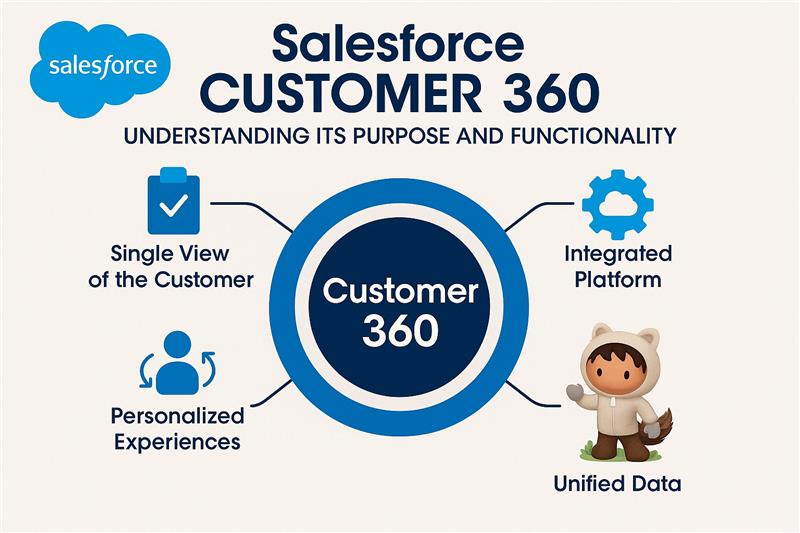Salesforce Customer 360: Understanding Its Purpose and Functionality
In today’s hyper-connected business world, understanding your customer is no longer optional—it’s essential. Companies interact with customers across multiple channels: marketing campaigns, sales touchpoints, customer service requests, and social media interactions. But these interactions often happen in silos, leaving businesses with fragmented customer data. This is where Salesforce Customer 360 comes into play—a solution designed to provide a single, unified view of every customer.
What is Salesforce Customer 360?
Salesforce Customer 360 is a comprehensive platform solution that allows organizations to connect and unify customer data across all Salesforce applications and external systems. Essentially, it helps businesses consolidate customer information scattered across multiple departments and touchpoints into one complete, accurate, and accessible profile.
Instead of relying on disconnected data sources or manually stitching together customer insights, Customer 360 enables a holistic view of your customer’s journey and interactions.
Key Purpose of Salesforce Customer 360
The main goals of Customer 360 are:
- Unified Customer Profile
It merges customer data from multiple Salesforce clouds—Sales Cloud, Service Cloud, Marketing Cloud, Commerce Cloud, and others—into a single identity. This ensures that every department has access to the same information. - Seamless Integration Across Systems
Customer 360 connects not only Salesforce apps but also external systems and data sources, enabling a comprehensive understanding of customer behaviour across platforms. - Enhanced Customer Engagement
By providing a 360-degree view, it empowers sales, service, and marketing teams to deliver personalized experiences and tailored solutions. - Data Accuracy and Trust
With a unified system, there’s less risk of duplicate records or outdated information. Decision-making becomes more reliable, and customers receive consistent experiences.
How Salesforce Customer 360 Works
Customer 360 works by linking customer identities across systems. Here’s a step-by-step look:
- Identity Resolution
Salesforce Customer 360 identifies individual customers across different systems. For example, a customer may exist in both Marketing Cloud and Service Cloud. Customer 360 maps these records to a single identity, eliminating duplicates. - Data Unification
The platform aggregates data from multiple sources—sales, service, marketing, commerce, social—and creates a unified profile containing all relevant information about the customer. - Real-Time Updates
Changes to customer data in any connected system are automatically synchronized, ensuring that all teams work with the most current information. - Actionable Insights
With unified data, Salesforce analytics tools like Tableau CRM or Einstein AI can generate predictive insights, personalized recommendations, and automated workflows.
Core Features of Salesforce Customer 360
- Single Customer ID: A unique identifier links all customer records across clouds.
- Data Integration: Connects Salesforce apps and external systems seamlessly.
- Data Governance: Maintains data quality, compliance, and security.
- Personalization: Enables targeted marketing campaigns and personalized service.
- Analytics and AI: Uses AI to predict customer behaviour and identify opportunities.
- Automation: Triggers workflows across departments based on customer actions.
Benefits of Salesforce Customer 360
- Better Customer Experiences: Teams can provide consistent, personalized interactions.
- Informed Decision-Making: Reliable, centralized data allows smarter business decisions.
- Increased Operational Efficiency: Reduces manual work and data duplication.
- Stronger Customer Relationships: Understanding the customer fully enables proactive service.
- Future-Ready Business: Supports omnichannel strategies and AI-powered insights.
Real-World Use Case
Consider a retail company using Salesforce:
- Marketing Team: Launches a personalized email campaign based on purchase history.
- Sales Team: Sees the same customer’s engagement history and offers relevant promotions.
- Service Team: Accesses all past service requests to resolve new issues efficiently.
All of this is possible because Customer 360 unifies the customer profile, ensuring everyone works from the same source of truth.
Conclusion
Salesforce Customer 360 is more than a tool—it’s a strategy for customer-centric business operations. By unifying data, streamlining operations, and enabling personalized engagement, it helps companies not just understand their customers but also anticipate their needs and build stronger relationships.
In an era where customer expectations are higher than ever, Customer 360 is the bridge between fragmented data and actionable insights, empowering businesses to deliver seamless, intelligent, and consistent experiences.

